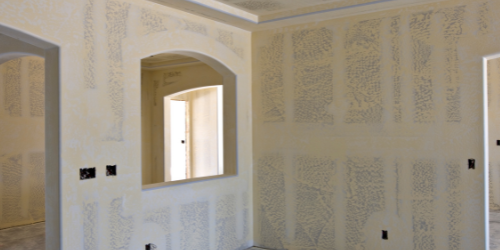Drywall installation is one of the most essential steps in creating smooth, flawless walls in your home. In Allen, Texas, homeowners and contractors alike prioritize quality when it comes to installing drywall because it serves as the foundation for interior finishes such as paint, wallpaper, and even decorative textures. At MJ Workforce Solutions, we understand how important this process is, and having the right tools can make all the difference. Whether you’re a DIY enthusiast or a homeowner looking to understand the process better, this guide will help you explore the tools needed for a professional drywall installation and why investing in quality matters.
Key Takeaway: The right tools combined with the right techniques are crucial for achieving a professional, smooth drywall finish. From cutting to finishing, every step requires precision and care.
Essential Tools for Drywall Installation
Cutting and Measuring Tools
Accurate measurements are the backbone of a successful drywall project. A high-quality tape measure ensures that each piece of drywall fits perfectly within the frame. Alongside this, a drywall T-square helps create straight lines for clean cuts. For the actual cutting, a sharp utility knife or drywall saw is indispensable. Proper cutting tools not only save time but also reduce waste and prevent mistakes that can compromise the wall’s finish.
Fastening Equipment
Once your drywall sheets are measured and cut, securing them properly is essential. A drywall screw gun or drill fitted with the right bit ensures that screws penetrate smoothly into studs without damaging the board. Additionally, drywall nails can be used, but screws offer more durability and a cleaner finish. A reliable stud finder also becomes a necessary companion to ensure each panel is anchored firmly.
Taping and Mudding Tools
Achieving a seamless surface requires quality joint tape and drywall compound, also known as mud. A set of taping knives in various sizes helps you apply the compound smoothly over seams and screw holes. A mud pan provides a convenient way to carry and manage the compound while working. For larger projects, consider using a drywall hawk for efficiency. These tools ensure that joints are blended perfectly, creating a base ready for painting or wallpaper installation.
Finishing Tools for a Flawless Look
Sanding Essentials
Sanding is the key to a smooth and even surface after mudding. A sanding sponge or a pole sander makes this process more manageable, especially for high or hard-to-reach areas. Investing in a dust-collection sanding system can also help maintain cleanliness and improve indoor air quality during the process. This step is vital before applying any finish, whether it’s paint, stain, or textured design.
Corner and Edge Tools
Corners often present challenges in drywall installation, requiring special attention. Corner trowels are designed to create clean, sharp edges where walls meet, ensuring a polished result. Additionally, using a corner bead, typically made of metal or plastic, strengthens and sharpens the outer edges, preventing future damage. These small details greatly enhance the longevity and visual appeal of your walls.
Specialty Tools
For homeowners looking to add unique touches, such as arches or custom wall designs, specialty tools like drywall rasps and circle cutters can be invaluable. These allow for more intricate cuts and shapes, giving your walls a customized, professional look. While these tools might not be necessary for every project, they can elevate the quality of specialty drywall installations.
Preparing Your Home for Drywall Work
Clearing the Space
Before beginning installation, it’s important to clear the work area of furniture and décor. This ensures safety and efficiency, making it easier to move large sheets of drywall. Covering floors with protective materials also prevents damage during the process.
Evaluating the Walls
Inspecting your framing is crucial before you start hanging drywall. Make sure studs are evenly spaced and there are no obstructions like wiring or plumbing issues. Addressing these elements early avoids complications during installation.
Considering Additional Services
While preparing your walls, you may also want to consider complementary updates, such as Wallpaper Installation for feature walls or refinishing your ceilings with Popcorn Texture Removal to achieve a modern, smooth finish. These enhancements can significantly increase your home’s value and appeal.
Common Mistakes to Avoid During Drywall Installation
Rushing the Process
Patience is key in drywall installation. Skipping steps, such as proper sanding or adequate drying time for mud, can lead to visible seams and imperfections that will show through paint or wallpaper later.
Using the Wrong Tools
Improvising with incorrect tools may seem like a cost-saving measure, but it often results in poor workmanship and additional expenses for repairs. Invest in the right tools for long-term satisfaction.
Neglecting Safety
Drywall installation involves handling large sheets, sharp tools, and dust. Wearing protective gear such as gloves, goggles, and a dust mask ensures your safety throughout the project. Additionally, ensure proper ventilation when sanding to reduce exposure to airborne particles.
Answering Common Questions
What size drywall sheets should I use for my home? Standard drywall sheets measure 4×8 feet, which works well for most residential walls. For taller walls, consider 4×12 sheets to minimize seams.
Can I install drywall on my own, or should I hire professionals? While DIY drywall installation is possible, achieving a flawless finish requires experience and the right tools. Hiring professionals ensures precision and saves time.
How long does it take for drywall mud to dry between coats? Drying time depends on the type of compound used and the room’s humidity, but typically it ranges from 12 to 24 hours between coats.
How Lighting Affects Drywall Appearance
Lighting plays a significant role in how your finished walls will look. Shadows can reveal imperfections, so proper sanding and even application of compound are essential. Natural light in Allen homes can enhance the beauty of smooth walls, making quality drywall work even more important.
The Relationship Between Drywall and Interior Design
Drywall isn’t just a structural element; it sets the stage for your home’s interior style. Smooth walls complement a variety of finishes, from bold paint colors to elegant wallpaper designs. For those looking to upgrade their spaces, services like Kitchen Cabinet Staining can further enhance the overall look and feel.
Why Choose Professional Drywall Services in Allen
If you want a professional finish without the stress, partnering with experts for Drywall Services is the best choice. At MJ Workforce Solutions, we provide comprehensive services to ensure every wall in your home is perfectly prepared for painting, staining, or decorative finishes. Contact us today to learn how we can help transform your space with care and precision.







